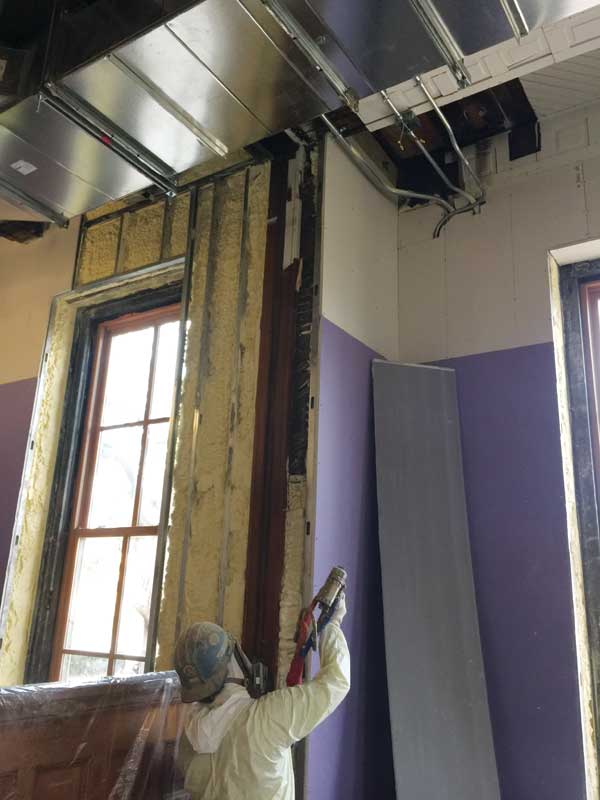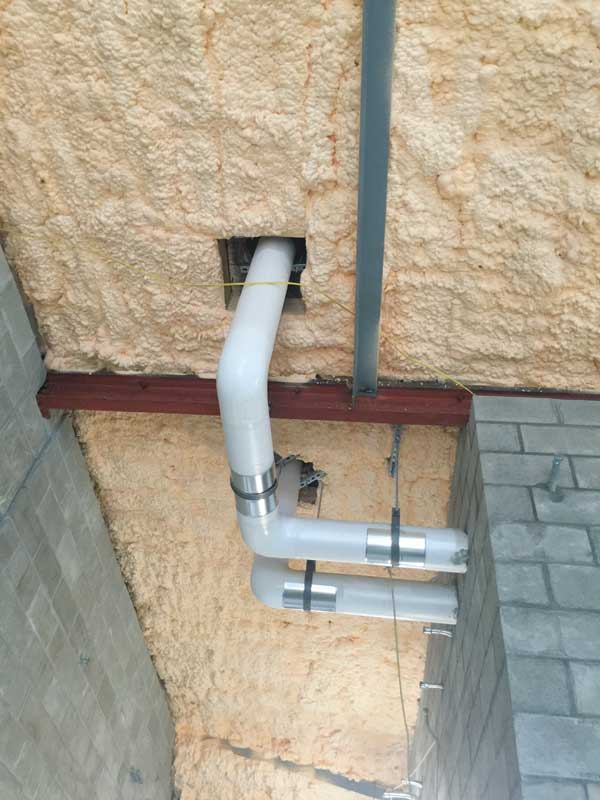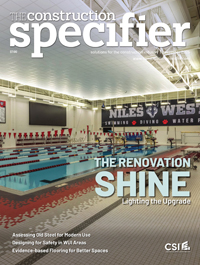Navigating the different densities of sprayfoam

Specification of open- and closed-cell SPF insulations in one renovation
The Natural History Building has been a distinguished landmark at the University of Illinois for well over a century. Built in 1892, the building was originally designed by the renowned Nathan Ricker—an Illinois alumnus himself and the first person to earn a degree in architecture in the United States. With an architectural look best described as High Victorian Gothic, the red brick structure sits on a rough stone foundation. Colored brick and stone adorn the exterior.
Since its inception, the 13,750-m2 (148,000-sf) educational facility has provided a functional space for college-level learning. However, the university closed the building in May 2014 due to significant structural deficiencies. Since then, the property underwent an extensive $70-million renovation aimed at making the building more structurally sound while transforming it into a modern, technologically advanced learning environment. The enhancement also focused on preserving the original architectural detail envisioned by Ricker, which ultimately led the Natural History Building to securing its place on the National Register of Historic Places in 1986.
One of the dramatic improvements to the building was a major enhancement to the envelope’s insulation. Biofoam Inc., a Chicago-based insulation, roofing, and waterproofing contractor, was brought in to handle this part of the retrofit.
Recognizing the variances in performance, cost, and best-use applications in the envelope for both low-density (i.e. open-cell) and higher-density (i.e. closed-cell) SPF, the project’s design team specified two types for the facility’s envelope. Following those specifications, Biofoam installed 250 mm (10 in.) of open-cell foam to the underside of the existing roof and 50 mm (2 in.) of closed-cell to the inside of the exterior masonry walls.
Application of the open-cell sprayfoam focused on the underside of the facility’s cathedral roof, up to 8.5 m (28 ft) in some areas. Scaffolding was assembled around many obstacles to apply the foam where ceiling heights were greatest, as the structure’s age does not allow for lifts above the first floor. The sprayfoam selected was a 0.50-pound variety that required no additional ignition barrier to meet the requirements of Appendix X—a test for fire resistance of assemblies in limited-access areas such as attics and crawlspaces. The open-cell foam is ideal for this interior application.
Open- or closed-cell SPF could have been used for this application. While the latter provides an integral vapor retarder required in colder climates, it must be applied in multiple passes to achieve the desired thickness and R-value. Open-cell SPF needs almost twice the thickness to achieve the same R-value as closed-cell SPF, but the entire thickness can be applied in a single pass, saving on installation labor and making the installed cost less than its closed-cell counterpart for a fixed R-value.

The closed-cell sprayfoam was applied to the exterior walls, behind the brick masonry. The 32-kg/m3 (2-pcf) medium-density foam acts as an insulation, air barrier, and moisture barrier. The Class A fire-rated sprayfoam adds structural strength to the building, with a compressive strength of 220 kPa (32 psi) and a tensile strength of 440 kPa (64 psi). Resistant to moisture, the sprayfoam also prevents the growth of mold and mildew. These characteristics are key indicators of its performance as an exterior sprayfoam product.
“With this enhancement, the Natural History Building is not only a world-class educational facility, but a true energy-efficiency performer,” said Tiffiny Flaim, president of Biofoam. “We expect long-term energy cost reductions to reach 30 percent. And, to boot, the facility is expected to achieve a [U.S. Green Building Council Leadership in Energy and Environmental Design] USGBC LEED Silver designation, in part because of the high-performance insulation applications.”
The Natural History Building brings all programs within the university’s School of Earth, Society, and Environment (including the atmospheric sciences, geography and geographic information science, and geology departments) under one roof for the first time. The historic structure is also home to teaching programs in the School of Integrative Biology, which encompasses animal and plant biology, along with entomology, as well as the Integrative Biology Honors program. Enhanced classroom interiors have been designed to encourage collaboration among students and teachers, and laboratories showcase the latest advanced technologies.
“With such a rich architectural and educational history, the Natural History Building is a gem of the university and the community,” added Flaim. “It was well-deserving of this significant upgrade.”



